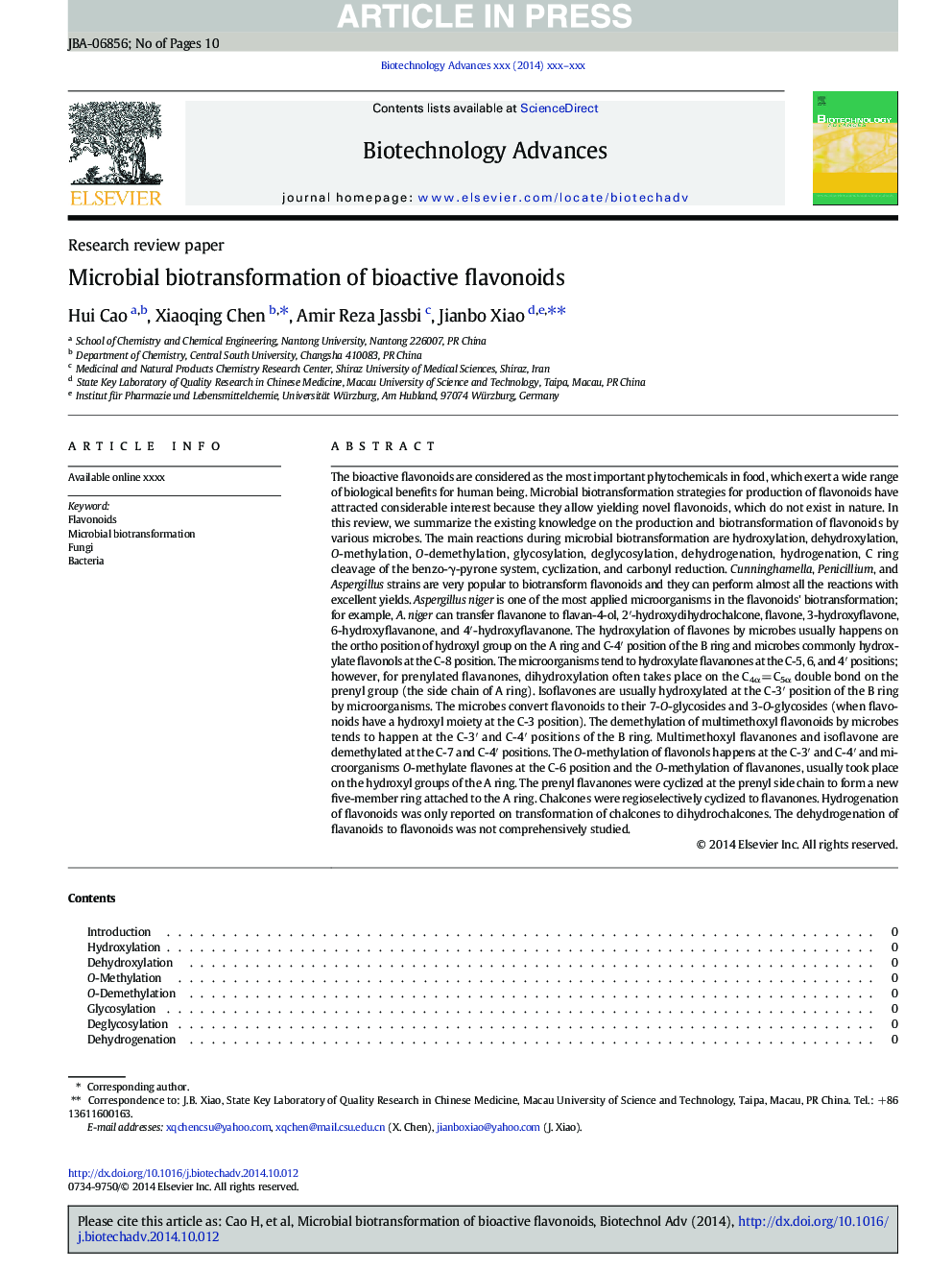| کد مقاله | کد نشریه | سال انتشار | مقاله انگلیسی | نسخه تمام متن |
|---|---|---|---|---|
| 10231493 | 1200 | 2015 | 10 صفحه PDF | دانلود رایگان |
عنوان انگلیسی مقاله ISI
Microbial biotransformation of bioactive flavonoids
ترجمه فارسی عنوان
بیوتکنفرانس میکروبی از فلاونوئیدهای زیست فعال
دانلود مقاله + سفارش ترجمه
دانلود مقاله ISI انگلیسی
رایگان برای ایرانیان
کلمات کلیدی
فلاونوئیدها، بیوتکنفرانس میکروبی، قارچ، باکتری،
موضوعات مرتبط
مهندسی و علوم پایه
مهندسی شیمی
بیو مهندسی (مهندسی زیستی)
چکیده انگلیسی
The bioactive flavonoids are considered as the most important phytochemicals in food, which exert a wide range of biological benefits for human being. Microbial biotransformation strategies for production of flavonoids have attracted considerable interest because they allow yielding novel flavonoids, which do not exist in nature. In this review, we summarize the existing knowledge on the production and biotransformation of flavonoids by various microbes. The main reactions during microbial biotransformation are hydroxylation, dehydroxylation, O-methylation, O-demethylation, glycosylation, deglycosylation, dehydrogenation, hydrogenation, C ring cleavage of the benzo-γ-pyrone system, cyclization, and carbonyl reduction. Cunninghamella, Penicillium, and Aspergillus strains are very popular to biotransform flavonoids and they can perform almost all the reactions with excellent yields. Aspergillus niger is one of the most applied microorganisms in the flavonoids' biotransformation; for example, A. niger can transfer flavanone to flavan-4-ol, 2â²-hydroxydihydrochalcone, flavone, 3-hydroxyflavone, 6-hydroxyflavanone, and 4â²-hydroxyflavanone. The hydroxylation of flavones by microbes usually happens on the ortho position of hydroxyl group on the A ring and C-4â² position of the B ring and microbes commonly hydroxylate flavonols at the C-8 position. The microorganisms tend to hydroxylate flavanones at the C-5, 6, and 4â² positions; however, for prenylated flavanones, dihydroxylation often takes place on the C4α= C5α double bond on the prenyl group (the side chain of A ring). Isoflavones are usually hydroxylated at the C-3â² position of the B ring by microorganisms. The microbes convert flavonoids to their 7-O-glycosides and 3-O-glycosides (when flavonoids have a hydroxyl moiety at the C-3 position). The demethylation of multimethoxyl flavonoids by microbes tends to happen at the C-3â² and C-4â² positions of the B ring. Multimethoxyl flavanones and isoflavone are demethylated at the C-7 and C-4â² positions. The O-methylation of flavonols happens at the C-3â² and C-4â² and microorganisms O-methylate flavones at the C-6 position and the O-methylation of flavanones, usually took place on the hydroxyl groups of the A ring. The prenyl flavanones were cyclized at the prenyl side chain to form a new five-member ring attached to the A ring. Chalcones were regioselectively cyclized to flavanones. Hydrogenation of flavonoids was only reported on transformation of chalcones to dihydrochalcones. The dehydrogenation of flavanoids to flavonoids was not comprehensively studied.
ناشر
Database: Elsevier - ScienceDirect (ساینس دایرکت)
Journal: Biotechnology Advances - Volume 33, Issue 1, JanuaryâFebruary 2015, Pages 214-223
Journal: Biotechnology Advances - Volume 33, Issue 1, JanuaryâFebruary 2015, Pages 214-223
نویسندگان
Hui Cao, Xiaoqing Chen, Amir Reza Jassbi, Jianbo Xiao,
